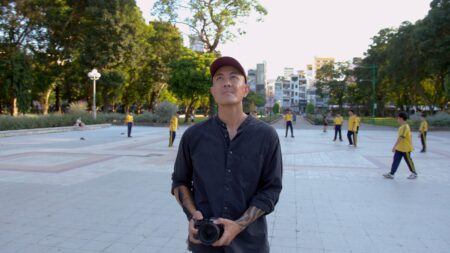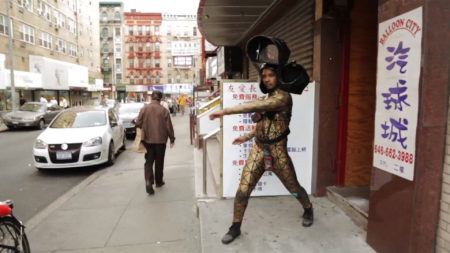Continue playing
(Time remaining: )
Play from beginning
Continue playing "{{ controller.videos[controller.getVideo(controller.currentVideo)].segmentParentTitle}}"
{{controller.videos[controller.getVideo(controller.currentVideo)].title}} has ended.
Rachel Rossin's Digital Homes
One of four new films from Art21’s spring 2021 programming
How do you create comfort and care in the realm of the digital? Synthesizing the traditional mediums of painting and sculpture with new technologies like augmented and virtual reality, Rachel Rossin fluidly blurs the digital and physical, exploring the emotional potential of an in-between space. The artist recounts the intensity of her childhood in Florida, how she taught herself to hack and program computer software, and her use of both the Internet and artmaking as vehicles for escape and refuge.
From her DUMBO, Brooklyn studio, Rossin works on a new painting and plays with the markerless motion capture software that she often uses for her virtual works. For VR works such as Skin Suits (2019) and Man Mask (2016), Rossin pulled from an archive of characters and imagery that she hacked from video games, including the male avatar from her teen years playing the popular first-person shooter game, Call of Duty. For Rossin, the male avatar is not just a creative choice, but a reaction to the reality of being a young woman in a male-dominated online gaming culture and the need to protect oneself from online harassment and bullying.
Working on a series of plexiglass sculptures for an exhibition with Rhizome and Hyundai Motor Company, Rossin uses her own body to shape and mold the panels into three-dimensional sculptures. The resulting forms act as hollow-body imprints of the artist and protective shields. The central image embedded into the plexi surface—a half-woman, half-bird harpy avatar that Rossin has used throughout her creative life—is fundamental to the artist’s sense of herself and the larger cultural experience of being in two places at once. “So much of our emotional, cognitive space [is] lived in virtual spaces,” says the artist. “For me, it always comes back to my own embodiment and how to anchor this very abstract loose [digital] space in the same dimension that I’m in.”
This film is among a collection that comprise Art21’s participation in the multi-institutional Feminist Art Coalition initiative. Feminist Art Coalition (FAC) is a platform for art projects informed by feminisms, fostering collaborations between arts institutions that aim to make public their commitment to social justice and structural change.
Credits
New York Close Up Series Producer: Nick Ravich. Directors: Danielle Brock and Vicky Du. Producer: Vicky Du. Editor: Winnie Cheung. Cinematography & Sound: Jia Li. Additional Camera: Julia Lohmann. Production Services: Meerkat Media. Color Correction: Addison Post. Sound Design & Mix: Gisela Fullà-Silvestre. Design & Graphics: Chips. Music: APM Music. Artwork Courtesy: Rachel Rossin. Archival Media: Hyundai Motorstudio Beijing, Pioneer Works, and Karen Rossin. Thanks: 14a, Marie Becker, Michael Connor, Elene Damenia, Rhizome, Rob Ruth, and Smoo (Studio Cat).
New York Close Up is supported by The Andy Warhol Foundation for the Arts; and, in part, by public funds from the New York City Department of Cultural Affairs in partnership with the City Council; Dawn and Chris Fleischner; and by individual contributors.
Digital exhibition of New York Close Up films is made possible in part by the New York State Council on the Arts.
Closed captionsAvailable in English, German, Romanian, Italian, Japanese, Korean, Chinese, Italian
Through the Art21 Translation Project, multilingual audiences from around the globe can contribute translations, making Art21 films more accessible worldwide. Translate this video now.
Interested in showing this film in an exhibition or public screening? To license this video please visit Licensing & Reproduction.
Rachel Rossin was born in 1987 in West Palm Beach, Florida, and lives and works in Brooklyn, New York. She received a Bachelor of Arts and Science from Florida State University. A self-taught programmer working in painting, installation, and virtual reality, Rossin examines the slippage between virtual and physical space, building hybrid sites for escape and reflection.
“The way that I was making art before I knew it was art, it was like making homes—just trying to find home.”
Rachel Rossin
Blended Realities
Cao Fei
Pierre Huyghe


